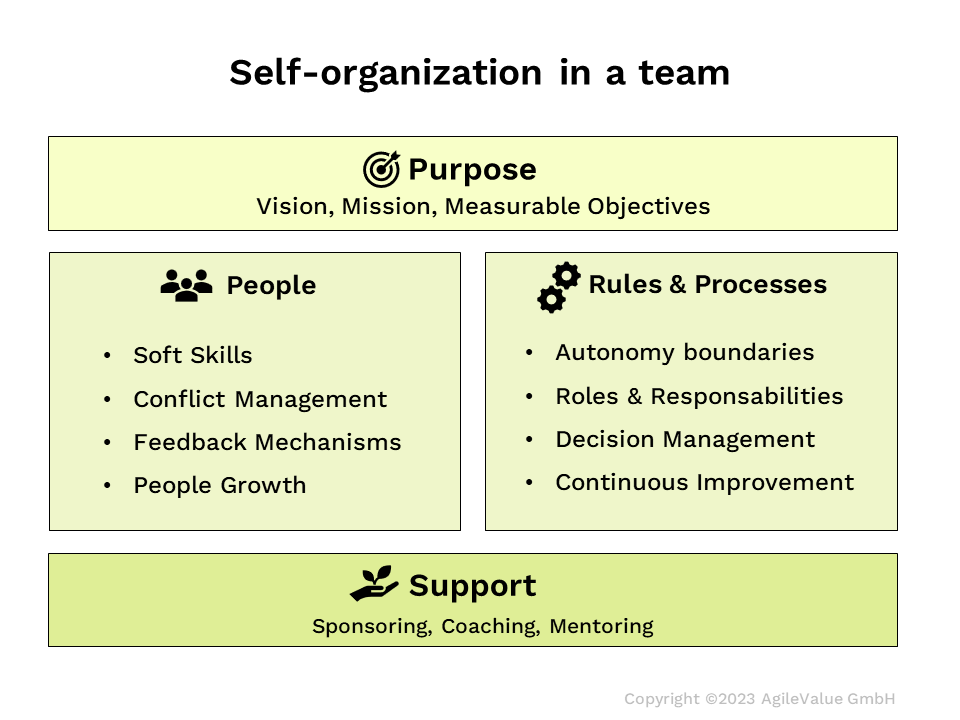Introduction
Self-organized teams are known for their agility, efficiency, and ability to adapt to changing circumstances, making them the foundation of sustainable organizations. In this article, I provide a step-by-step guide on how to build self-organized teams based on my experience as a coach in big agile transformations.
Understanding Self-Organized Teams
Self-organized teams, also known as autonomous or self-managed teams, are groups of individuals who work collaboratively with minimal supervision or external intervention. These teams are responsible for planning, executing, and evaluating their work, making decisions collectively, and continuously improving their processes.
Benefits of Self-Organized Teams
Before delving into the steps to build self-organized teams, let’s take a moment to appreciate the numerous benefits they offer to organizations:
- Increased productivity: Self-organized teams tend to be more productive because team members have a sense of ownership and responsibility for their work.
- Better and faster decisions: With the authority to make decisions, self-organized teams can respond quickly to changing conditions and opportunities and use their collective intelligence to make better decisions.
- Enhanced innovation: Autonomy fosters creativity and innovation, as team members feel empowered to experiment and explore new ideas.
- Better employee satisfaction: Self-organized teams often report higher job satisfaction, as they have more control over their work and faster personal growth.
- Improved adaptability: These teams are better equipped to adapt to unforeseen challenges, making organizations more resilient.
The building blocks for self-organized teams
Requirements for building self-organization can be split into 4 dimensions: Purpose, People, Rules & Processes and Support as shown in the following figure:

Let’s take a look at how to fulfill these requirements step by step.
Step 1: Define a team sponsor
The team founder or sponsor has the responsibility to guide the team from its creation until it has reached the required autonomy. He acts as a proxy between the team and the organization, ensuring that the team is aligned with the objectives of the company, and protecting the team from interference in the team.
The sponsor is generally the person in the organization with the greatest interest in the creation of the team. He must be sufficiently experienced to be able to help recruit the foundation team members.
Step 2: Define the team mission
Clarity of purpose is essential for aligning later team efforts. To create ownership, let the team members elaborate on the vision and mission statements based on the team’s purpose.
Let also the team define its goals based on the objectives given by the team sponsor and how they want to measure the achievement of these goals.
By the way, let the team choose their own team’s name, as it is a fun activity which brings team members even closer together.
Step 3: Establish boundaries of autonomy
Clearly define the boundaries within which the team operates.
The level of self-organization in the team corresponds to the level of autonomy in their decisions. For each type of decision (hiring, purchasing, solution design…) let the team and its stakeholders agree how the decisions should be made. The delegation poker game uses a practical scale of 7 levels of delegation to agree with stakeholders the autonomy of the team for each case or situation.
Empowering the team to make decisions more autonomously is the key to creating more accountancy for their results. Therefore, the stakeholders must be convinced of the benefits of self-organization.
The boundaries of autonomy are shaped by the company obligations. For instance, the financial or legal requirements.
Define the expectations from the company and the consequences when the expectations are not met. For example, make clear what financial results are expected and what happens when the teams write red figures.
Step 4: Ensure people have the required skills
Diversity in skills and perspectives is key for problem-solving and creativity in self-organized teams.
Self-organized teams require more soft skills than traditional teams, as the leadership is shared between team members.
The top soft skills required by self-organized teams are:
- Empathy
- Communication
- Adaptability
- Accountability
You can find some tips to improve these skills in this article: Soft skills for agile teams.
Self-organized teams are more subject to conflicts, as they work more closely than in traditional teams. Ensure that the team has conflict resolution skills to be able to handle divergent opinions.
Step 5: Establish rules & processes
5.1 Performance indicators
Managers accept to lose control only they are reassured that the team is achieving its objectives.
Define the key performance indicators, the OKRs or other measurable objectives with the team.
Do not use the Sprint Velocity from the Scrum Framework as a performance indicator. The complexity measured by the team in story points is very subjective. Prefer estimates of the business value with score cards.
Make the data accessible to the team and all stakeholders, and invite the team to continuously learn from them.
5.2 Roles and responsibilities
In self-organized teams, responsibility is not diluted, but on the contrary acknowledged by team members and everyone feels accountable for the team’s results.
Clear roles also reduce the complexity in the team because the team has not to decide for each situation: “who would like to take care of that?”.
Invite the team to define roles with the associated expectations, and let the team members choose these roles according to their skills and interests.
5.2 Decision processes
Decision processes are the foundation of self-organized teams. For each decision, for example for salary raises or bonuses, let the team agree which team member needs to be involved and what is the right decision method (majority voting, systemic consensing or any other…).
This is key to make each team member accountable for the decisions made by the team. Let the team reflect on the quality of their decisions and improve their processes.
Step 6: Provide resources and support
Ensure that the team has access to the necessary resources, training, and support to accomplish their tasks. The team sponsor ensures at the beginning that the team can remove obstacles and address any issues that hinder their progress.
The risk for conflicts is higher in self-organized teams, so ensure that the organization has adequate facilitators to support the team in case they cannot solve a conflict on their own.
Step 7: Foster continuous learning and people growth
Regular feedback is crucial for self-organized teams to assess the team’s health and make improvement. In my experience as a coach, I have met many teams which have lost team members because they were unable to detect conflicts in time.
The agile retrospective is an essential tool for self-organized teams to get insights about their work and to foster their continuous improvement. Teammeter combines health check surveys with a retrospective tool to guide the team on continuous improvement.
As no external authority can assess people as team members, performance appraisals can be replaced with 360 feedback from the team.
In self-organized teams, people are not only responsible for the team outcomes but also for their personal development. Let the teams develop their skills continuously, as team members know exactly what they need to perform their work. The skill matrix is an essential tool to make the skill gaps visible and make a collective skill development plan. The skill matrix in teammeter uses a company-wide skill catalog, making it for employees to assess their skills.
As the personal goals of a team member may not be in line with the team mission, the team members still need external mentoring from the organization to find the right career path inside the organization. Ensure that a mentoring system is part of the support provided to the team.
Conclusion
Ultimately, the goal of promoting self-organization is to create a culture of trust, empowerment, and collaboration within teams, where managers act as facilitators and enablers rather than controllers. Recognize that letting go of control is a gradual process, and it may take time for managers to fully adapt to the new paradigm.
The same applies to team members who are learning to deal with these new responsibilities. Be patient and persistent in supporting people through this transition.
Self-organized teams are fascinating because you can observe each team member growing quickly and taking a part of the team’s leadership. That is the magical recipe for extraordinary results.

